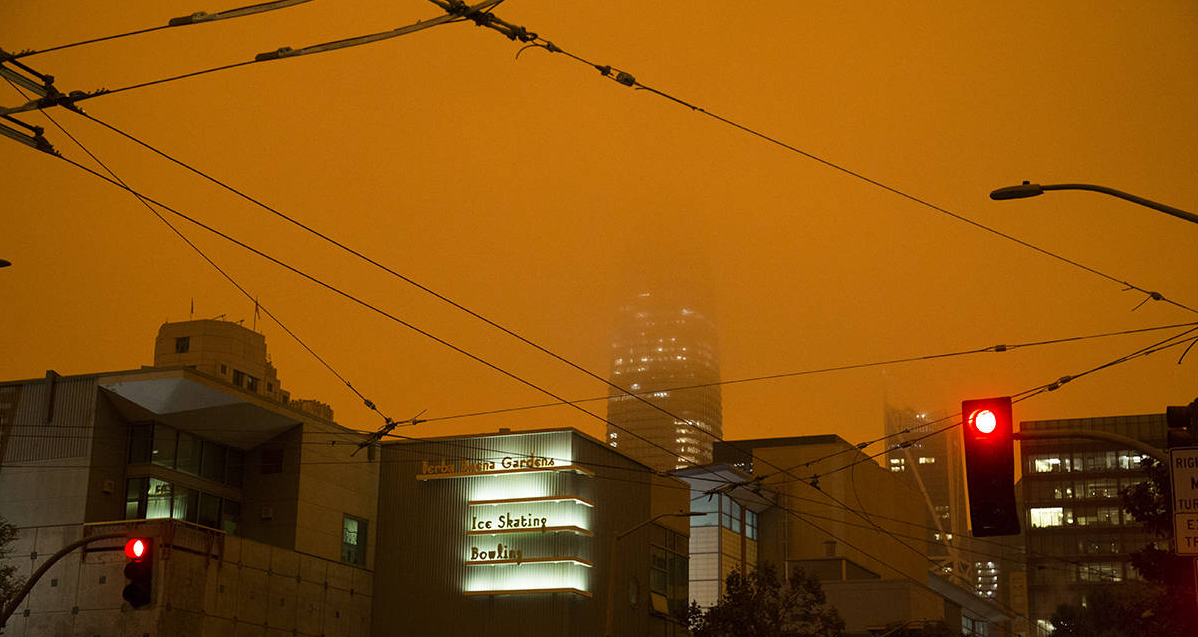
Figure 1: The skies of the Bay Area, turned orange from smoke and debris in the air. Image by Kevin N. Hume.
Caroline Lonneman, Eco Rep
Caitlin Griffith, Sustainability Coordinator

Figure 1: The skies of the Bay Area, turned orange from smoke and debris in the air. Image by Kevin N. Hume.
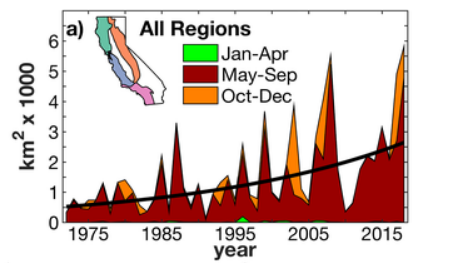
Figure 2: A graph illustrating each year (1970-2018) and how many kilometers were burned.
There has been a lot of talk about the “new normal” of 2020. This is in reference to our new ways of life during the COVID-19 pandemic. However, this has more recently expanded to another subject—the new normality of more intense natural disasters. Hurricanes in the Gulf of Mexico are increasing in intensity. For the first time in recorded history, two powerful hurricanes occupied the Gulf at one time. California’s wildfires are worse this year than any year on record. The skies of California, emitting an orange hue, have been shared across social media. Scientists have pointed to the underlying cause of these events: climate change.
While forests of California routinely experience wildfires as a part of their ecosystem’s natural cycle, the past few years have seen increased devastation. This year in particular has seen a record breaking 2.2 million acres burned, compared to a 2000-2019 average of 720,000 per year. Hundreds of homes have been destroyed as fires continue to rage, and thousands of people are under orders to evacuate.
It is now well established that climate change plays a large part in the rise of wildfire damage, the growing length of the wildfire season, and the increase of individual wildfires starting. There has been a recorded fivefold increase in annual burned area from 1972 - 2018 that has been attributed to “drying of fuels promoted by human-induced warming.” California wildfire season typically ranges from May to October, but California Department of Forestry and Fire Protection estimates that this has increased by 75 days in some parts due to climate change. The first wildfires of the 2019 season began on May 7 and lasted all the way until December 14.
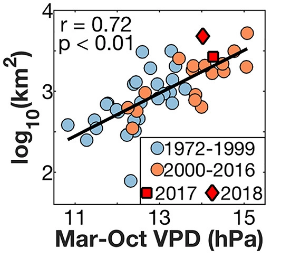
Figure 3: A graph illustrating the correlation between VPD and kilometers burned.
An atmosphere’s vapor pressure deficit (VPD) is an indicator of wildfire probability. A VPD is a simple measure of how arid an environment is—and how susceptible that environment is to decreased rainfall and increased wildfires.
Aridity directly increases with higher temperatures and causes more forest, grassland, and other wildfire fuels to dry out for longer periods of time. Since there has been a human-induced global rise in average temperature of about 1°C (2°F) due to global warming, aridity has increased in response. The effects of increased aridity, measured as VPD, can be seen in the graph to the right.
It is unknown just how much climate change will affect California’s wildfires, but California state officials and scientists warn of growing dangers. “Wildfires in California are going to continue or get worse,” stated Stanford University climate scientist Michael Goss, who is the co-author of a recent paper examining the effects of climate change on wildfires. According to his research, the number of days with “fire weather”, a term used to describe days with high risk of wildfires starting or growing, have doubled as the earth’s temperature has risen 1 C. Goss predicts that this pattern will continue with as average temperatures continue to rise.
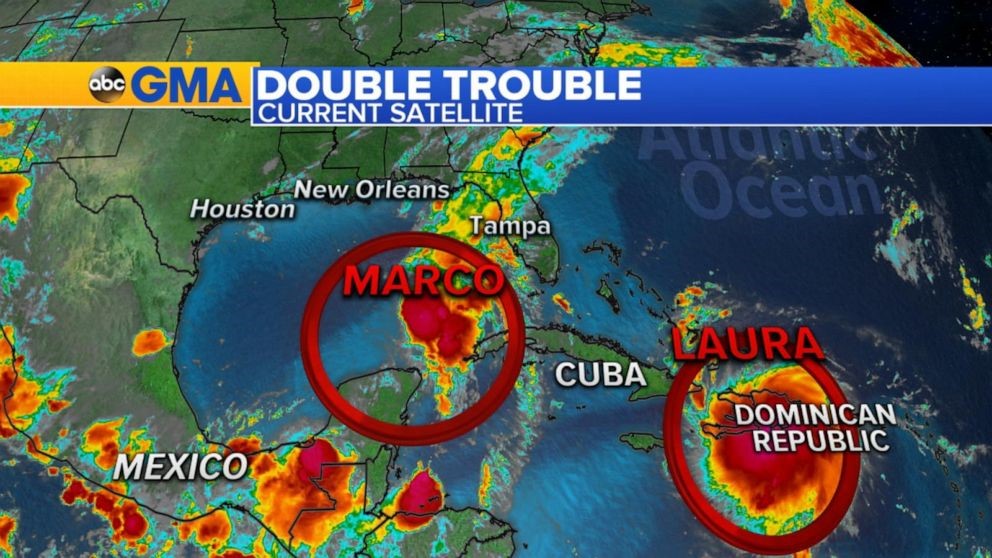
Figure 4: Hurricanes Marco and Laura head toward the Gulf of Mexico in late August 2020. Image by ABC News.
Decreases in rainfall in places such as California has led to a dramatic increase in precipitation in others. This increased precipitation is a direct result of the heightened strength of storms and hurricanes.
Texans remember the devastation of 2017’s Hurricane Harvey. Millions were affected by its destruction. Like other recent hurricanes such as Hurricane Laura, it was characterized by rapid intensification just before landfall, causing more damage than predicted. Now with Hurricane Laura and Marco, for the first time two severe hurricanes occupied the Gulf of Mexico at the same time.
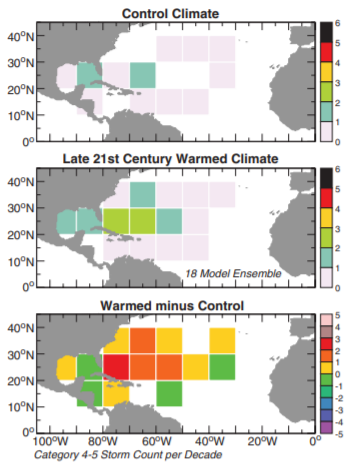
Figure 5: A map of the estimated frequency of category 4-5 storms per decade in the Atlantic.
The frequency of hurricanes has remained mostly unchanged—although 2020’s Hurricane Laura was the earliest “L”- named hurricane to date. What has changed is each storm’s intensity. A steady average of 90 hurricanes are still occurring each year, but the amount of those hurricanes reaching category 4 and 5 has dramatically increased. While this is still being studied, it is predicted by some hurricane models that the frequency of category 4 and 5 hurricanes may double by the end of the 21st century if trends hold steady.
This intensification is attributed to rising ocean temperatures. A warmer ocean sends energy and moisture into the atmosphere above it, giving a hurricane all it needs to power up and lengthen its lifespan. This is not unlike how a charger would charge a cell phone. The deeper the warmth extends into the depths of the ocean, the more energy is given to the storm. Tropical storms, typhoons, and cyclones are predicted to follow suit.
We are already living in a world affected by climate change. Changes present themselves differently and uniquely across the world—some are facing increased rainfall and storms where others are experiencing longer droughts and harsher heat. Some are experiencing rises in ocean levels and some are experiencing the melting of permafrost. These events are increasing in frequency and severity. The world has already seen the first waves of climate change refugees. The science is still evolving, but if climate change continues, we will have to prepare our societies for more adverse conditions.
Thankfully, we have begun to see plans aimed at mitigating climate change. Some states, such as Michigan and California, have made plans to move toward carbon-neutrality. New York recently announced a plan to invest in alternative energy sources, and the science of renewable energy is always improving. China has announced the country’s intention to be carbon neutral by 2060, joining a long list of countries that have already made carbon neutrality commitments. The United States is the world’s #2 carbon polluter (just after China) and has not yet joined this list.
The effects of climate change continue to become more evident with each passing season. As seasons pass, we move closer to the thresholds set by the International Panel for Climate Change (IPCC [International Panel for Climate Change] ), the United Nations body for examining climate change. The IPCC has prepared an extensive report on what may happen as the earth approaches an average increase of 1.5°C. Consequences include extreme droughts, precipitation, flooding, and increased storm destruction beyond what we are currently experiencing. Populations at disproportionately higher risk of experiencing adverse effects of climate change include vulnerable populations like indigenous peoples, impoverished communities, and communities dependent upon agriculture and coastal livelihoods. Climate change is projected to exacerbate poverty rates as well as reduce crop yields. Earth is expected to move from the current increase of 1°C to 1.5°C before the end of the century. The report calls out various adaptation opportunities to reduce risks associated with these changes. Some opportunities are focused on mitigating the ecological impact, such as sustainable agriculture, ecosystem restoration, and applying local and indigenous knowledge. Others address social impacts of climate change, like developing social safety nets, community-based adaptation, and green infrastructure. If we are to control the effects of worsening climate change, the time to act is now.
Sources
Amadeo, Kimberly. Hurricane Harvey Shows How Climate Change Can Impact the Economy. 24 September 2020, https://web.archive.org/web/20201006164840/https://www.thebalance.com/hurricane-harvey-facts-damage-costs-4150087 https://www.thebalance.com/hurricane-harvey-facts-damage-costs-4150087.
Bender, Morris A., et al. “Modeled Impact of Anthropogenic Warming on the Frequency of Intense Atlantic Hurricanes.” Science, American Association for the Advancement of Science, 22 January 2010, https://science.sciencemag.org/content/327/5964/454.full.
California Department of Forestry and Fire Protection (CAL FIRE). “2020 Incident Archive.” Organization Image, https://www.fire.ca.gov/incidents/2020/.
“Climate Change Is Causing More Rapid Intensification of Atlantic Hurricanes - Yale Climate Connections.” Yale Climate Connections, 30 August 2020, https://www.yaleclimateconnections.org/2020/08/climate-change-is-causing-more-rapid-intensification-of-atlantic-hurricanes/.
“Each Country’s Share of CO2 Emissions.” Union of Concerned Scientists, 2020, https://www.ucsusa.org/resources/each-countrys-share-co2-emissions.
Gerretsen, Megan Darby and Isabelle. “Which Countries Have a Net Zero Carbon Goal?” Climate Home News, Climate Home, 22 September 2020, https://www.climatechangenews.com/2020/09/17/countries-net-zero-climate-goal/.
Gillis, Justin, and Nadja Popovich. “The U.S. Is the Biggest Carbon Polluter in History. It Just Walked Away From the Paris Climate Deal.” The New York Times, The New York Times, 1 June 2017, https://www.nytimes.com/interactive/2017/06/01/climate/us-biggest-carbon-polluter-in-history-will-it-walk-away-from-the-paris-climate-deal.html.
Hersher, Rebecca, et al. “Everything Is Unprecedented. Welcome To Your Hotter Earth.” NPR, NPR, 28 August 2020, https://www.npr.org/2020/08/28/905622947/everything-is-unprecedented-welcome-to-your-hotter-earth.
“How Climate Change Is Making Hurricanes More Dangerous - Yale Climate Connections.” Yale Climate Connections, 21 July 2020, https://www.yaleclimateconnections.org/2019/07/how-climate-change-is-making-hurricanes-more-dangerous/.
“How Climate Change May Be Impacting Storms Over Earth’s Tropical Oceans - Climate Change: Vital Signs of the Planet.” NASA, NASA, 20 March 2020, https://climate.nasa.gov/blog/2956/how-climate-change-may-be-impacting-storms-over-earths-tropical-oceans/.
IPCC. “Summary for Policymakers.” Global Warming of 1.5°C, 2018, https://www.ipcc.ch/sr15/chapter/spm/.
Ives, Mike. “A Remote Pacific Nation, Threatened by Rising Seas.” The New York Times, The New York Times, 2016, https://www.nytimes.com/2016/07/03/world/asia/climate-change-kiribati.html.
Lewis, Sophie. “California Wildfires Have Already Burned 2.2 Million Acres in 2020 - More than Any Year on Record.” CBS News, CBS Interactive, 9 September 2020, https://www.cbsnews.com/news/california-wildfires-burn-2-million-acres-record-breaking/.
Linsey, Rebecca, and LuAnn Dahlman. “Climate Change: Global Temperature: NOAA Climate.gov.” Climate Change: Global Temperature | NOAA Climate.gov, 14 August 2020, https://www.climate.gov/news-features/understanding-climate/climate-change-global-temperature.
Miller, Brandon, and Judson Jones. “Laura ‘Rapidly Intensified’ Overnight. Here’s What That Term Means.” CNN, Cable News Network, 26 August 2020, https://www.cnn.com/2020/08/25/weather/hurricane-laura-rapid-intensification/index.html.
Myers, Steven Lee. “China’s Pledge to Be Carbon Neutral by 2060: What It Means.” The New York Times, The New York Times, 2020, https://www.nytimes.com/2020/09/23/world/asia/china-climate-change.html.
Roth, Cheyna, and Garret Ellison. “Michigan Would Be Carbon-Neutral by 2050 under Whitmer Climate Change Plan.” Mlive, 23 September 2020, https://www.mlive.com/public-interest/2020/09/michigan-to-be-carbon-neutral-by-2050-under-whitmer-climate-change-plan.html.
Williams, A. Park, et al. “Observed Impacts of Anthropogenic Climate Change on Wildfire in California.” AGU Journals, John Wiley & Sons, Ltd, 4 August 2019, https://agupubs.onlinelibrary.wiley.com/doi/abs/10.1029/2019EF001210.